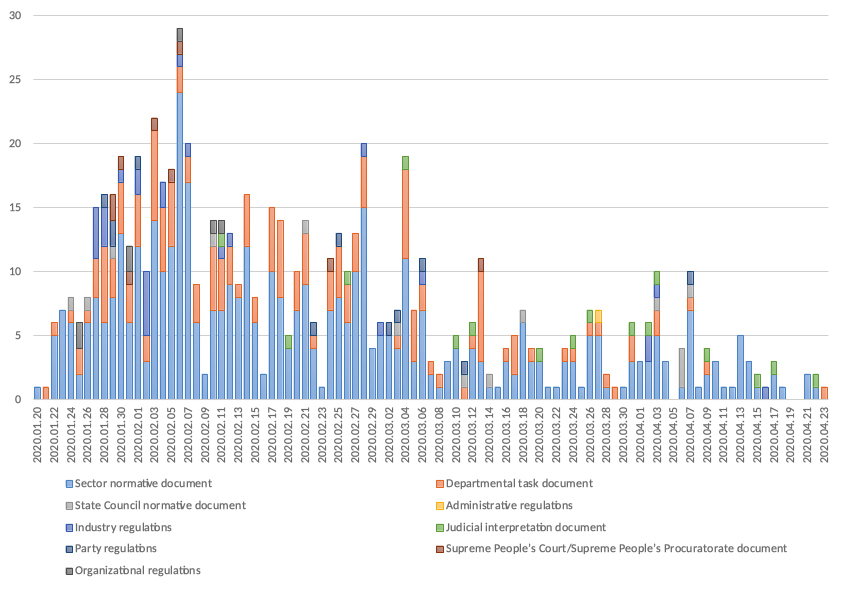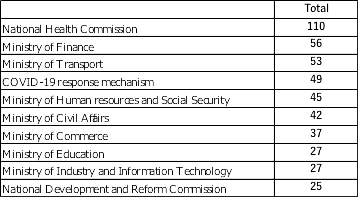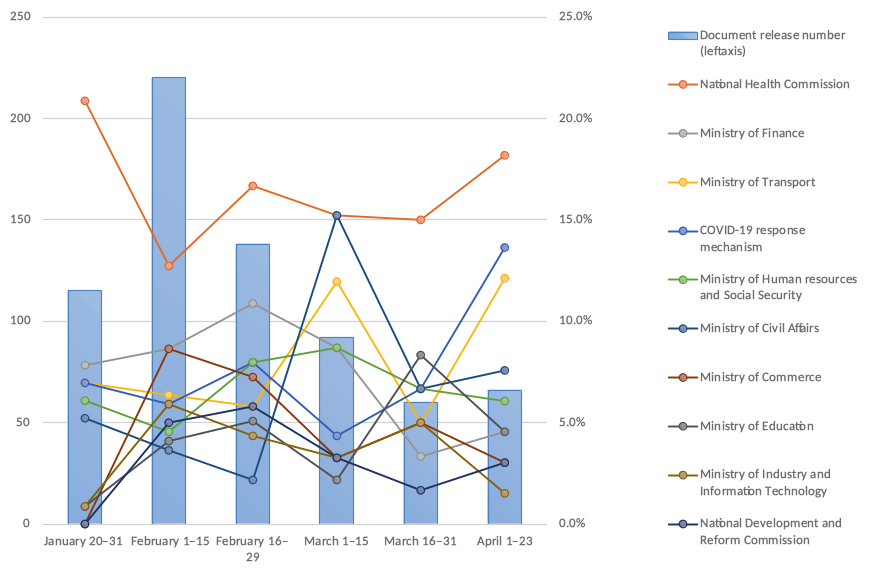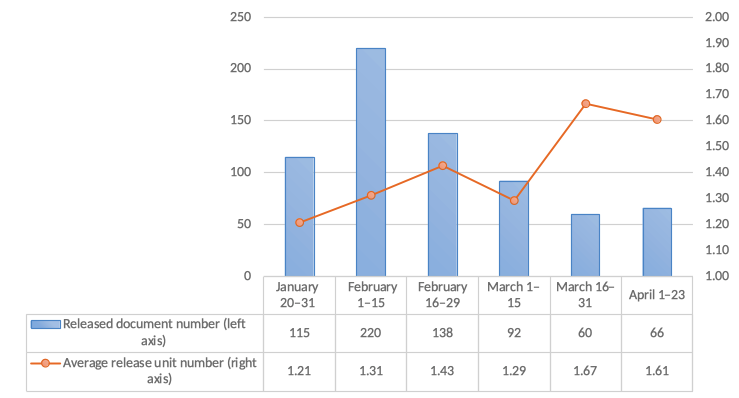Contents *Unauthorized reproduction is prohibited
SPF China Observer
HOMENo.27 2020/04/30
Response of Chinese government bureaucracy to COVID-19:
Organizing policy documents released January 20, 2020–April 23, 2020
Asei Ito (Associate professor, Institute of Social Science, The University of Tokyo)
Bureaucratic response to the coronavirus crisis
The novel coronavirus has already brought about a global crisis. It is even changing world history in the sense that the Great Depression brought about a comparable crisis. The impact that it has had on China is significant. The time divisions that have become familiar until now, such as the “reform and open period,” may no longer be valid after 2020.
It is uncertain whether the Chinese economic growth trajectory that has been sustained in the past will continue in the future. Even in terms of economic impact, the economic index announced in March 2020 for January–February of the same year was shocking[1]. The growth rate for the first quarter of 2020 announced in April was -6.8%, and this is a situation that has not been experienced since the reform and open period[2]. On the other hand, economic recovery has progressed since March and some indicators have improved. However, the possibility of the second wave of infection cannot be ruled out, and it is difficult to foresee the future when the European and U.S. economies are expected to undergo a significant negative growth in the second quarter[3]. A World Bank report released at the end of March predicted that the growth rate of the Chinese economy in 2020 would be 2.3% at baseline and 0.1% in a more severe, low-level scenario[4]. At the World Bank online seminar held on April 23, Aaditya Mattoo, Chief Economist of the East Asia and Pacific Region, pointed out that the likelihood of low-level scenarios are increasing[5].
Regarding the Chinese government's response, opinions are divided on how to evaluate its vulnerability and resilience. While the delay of its initial move until the first half of January has been pointed out, after January 23, the government has shifted to a strong policy enforcement, including city lockdowns. When the main epidemic areas were contained in China, many argued that the outbreak of the novel coronavirus indicated the vulnerability of China’s political system[6]. However, the virus containment by the subsequent lockdown control suppressed new infections. As a result, as early as the second half of February, production recovery has been promoted in regions other than Hubei Province and Beijing[7].
Since the lockdown of Wuhan and surrounding cities on January 23, the Chinese government had moved swiftly. Needless to say, in view of the series of actions taken by the Chinese government, the following policies are significant: the Central Leading Group on Responding to the Novel Coronavirus Disease Outbreak (leading group below), whose establishment was decided at the assembly of the Standing Committee of the Central Political Bureau of the Communist Party, the highest decision-making body in China, and the same meeting on January 25; and on a more practical level, the Executive Committee of the State Council[8].For example, the contents of the leading group meeting held on January 26 were varied. Among major policies, some of its main contents included the following: (1) request party committees and governments in each region to acknowledge and agree that the current virus outbreak is serious, (2) preferentially provide medical supplies such as protective equipment and masks to Hubei province and Wuhan, and renovate hotels as quarantine areas, (3) request to establish a coronavirus response leading group in each area, (4) demand strict isolation of patients who tested positive, (5) postpone or reduce meetings and large events, and conduct tests in public transportation, (6) reduce the flow of people by extending the Lunar New Year period and adjusting the school reopening period, (7) strengthen the training of doctors and nurses with the aim of maximally reducing the mortality rate, and promote scientific research and vaccine research, and (8) disclose quarantine information as appropriate[9].
A policy would not be effective without a system that further specifies the policy decided by the top layers of the government and the Communist Party and transmits it to the local level through the command system of each department. To clarify both the vulnerabilities of delayed initial response to the novel coronavirus, and resilience of the rapid first wave containment, we must pay attention to the function (and malfunction) of the bureaucracy.
In observing the policy enforcement process of Chinese bureaucracy, the author believes that the present novel coronavirus case has important implications. The crisis of the spreading virus was sudden, and prompt policy enforcement was required. An immediate application of power, so to speak, was necessary. In addition, it was common for the title of the policy document called “Novel Coronavirus Measures.” In other words, the policy response was made visible. The US–China trade war that had intensified since 2018 also exerted a significant burden on the Chinese economy. As such, measures have been taken in terms of trade policy, employment policy, and economic measures. However, even a policy that could be interpreted as a measure against the US–China trade war, a description like this is not usually made: “This tax reduction policy will be implemented in order to respond to the US–China trade war.” Because of this, it is necessary to position the policy from its planning period and situational evidence. In other words, understanding the response of the Chinese government bureaucracy to US–China trade measures involves certain difficulties because it has neither been concentrated over time nor visualized. On the other hand, China’s huge bureaucratic response to the crisis caused by coronavirus was concentrated as to time period, and it can be observed through tabulating policy documents.
Therefore, this paper aims to understand the trends and changes in the composition of countermeasures of each section of the Chinese government and related organizations from January to April 2020 in a sequential and quantitative manner[10]. The policy document database of the Chinese government,“北大法宝 (Beida Fabao)” (https://www.pkulaw.com/), was used. As we will see, this database is not a complete complement of policy documents, but it is still useful. It should be noted that the results shown here are tentative, as further confirmation will be made in the future to increase the capture rate of documents in the database.
When was the peak of the policy document release?
First, 706 documents were collected as COVID-19 countermeasure-related documents released by the central government departments, the Central Committee, and related organizations in the 94 days from January 20 to April 23, 2020[11]. By simple calculation, averaging 94 days, 7.4 policy documents were publicly released each day.
Figure 1 shows the number of releases per day, using 691 data that included the date and time of release. Since the notification that the National Health Commission legally designated COVID-19 as an infectious disease on January 20th[12], several policy documents were released, with the peak from February 3 to 8. More specifically, it peaked on Thursday, February 6, exactly two weeks after the city lockdown in Wuhan (Thursday, January 23) on Thursday, February 6, with a total of 29 central government documents released. Of these, 24 were “sector-normative documents” in which each department of the State Council indicated policy directions. The second peak appeared from late February to around March 4. The number of announcements decreased on February 9, 16, and 23, all of which were Sundays. Conversely, on January 26 and February 2, many departments continued to work throughout Chinese New Year (this year’s Lunar New Year’s Day was January 25). At least one document was published each day for 76 consecutive days from January 20 to April 4.

Note: 706 public documents on infectious disease control published by the central government departments and the Central Committee between January 20 and April 23, 2020, were tabulated. The figure shows 691 cases that excluded 15 cases without dates.
Source: Compiled by the author from the feature column in Beida Fabao(https://www.pkulaw.com/)(Downloaded April 26th, 2020).
Which department issued many measures/instructions?
Next, let us look at the composition of sections that released the policy documents. Figure 2 shows the top 10 departments and organizations in terms of the number of documents released. In a total of 706 documents, there were 118 departments,organizations, and groups, including joint names. Looking at the major sectors, the National Health Commission was the first with 110 cases; the second was the Ministry of Finance that put in place policies such as tax cuts and deductions; and the third was the Ministry of Transport, which carried out the transportation of supplies and infection control measures during the Spring Festival with 52 cases, and the fourth was the “Joint response task mechanism for the prevention and control of COVID-19”abbreviated as “COVID-19 response mechanism” below) with 49 cases[13].
The National Health Commission that came first can be described as a central bureaucratic mechanism for infectious disease control that releases the data of those infected by the novel coronavirus. The “COVID-19 response mechanism” that came in fourth place, is a cross-ministerial liaison entity that was newly established on January 21, headed by the National Health Commission, with a total of 32 participating departments[14]. Although the data says 49 documents, the number of “COVID-19 response mechanism” documents is actually larger, and it is drawing attention as a new organization established during the crisis response. The first document of the “COVID-19 response mechanism” registered in this database was announced on January 23, 2020. However, the document number states “Pneumonia Mechanism Document (2020) No. 2 (肺炎機制発〔2020〕2号).” We can see that this was the second document created by the “COVID-19 response mechanism” (see Supplementary Figure 1). However, after searching the Chinese Government State Council website for the document by the “COVID-19 response mechanism,” the first document was not listed. It is likely that the document capture rate of the database was higher[15].

Source: Same as Figure 1.
How has the department for coronavirus response transitioned?
The next issue is how the content of the response and its responsible entity have changed over time. The key points of the policy can be found in the released documents by the Standing Committee and the leading group, from which the main trends can be understood. As already pointed out in newspaper reports, the Chinese government has gradually shifted from infectious disease control to production recovery. Figure 3 shows the proportion of each sector's participation in the document release, divided into six periods to confirm the response of the bureaucracy.
When dividing the timeframe of the Chinese government’s COVID-19 measures, the following divisions can also be considered: before and after the city lockdown was determined (January 23 or 25), the extended Lunar New Year holiday period (February 9), and General Secretary Xi Jinping’s visit to Wuhan (March 10). Here, as a rudimentary analysis, we simply divided the time into the following six periods for tabulation: (1) until January 31, (2) February 1 to 15, (3) February 16 to 29, (4) March 1 to 15, (5) March 16 to 31, (6) April 1 and beyond.
According to this, the National Health Commission was consistently at the center of the response from January 20 to April 23. Looking at the roles of other institutions, the relative ratio for the Ministry of Finance and the Ministry of Commerce increased in February; for the Ministry of Civil Affairs and the Ministry of Education in March; and “COVID-19 response mechanism” again and Ministry of Transport in April. One thing that can be pointed out is that the participation rate of the National Development and Reform Commission, which has led major structural reforms in the Chinese government bureaucracy, is 10th for the full period, and that it consistently did not stand out (data aggregated by week is shown in Supplementary Figure 2). In response to the crisis, the imminent epidemic prevention measures, production restoration, employment maintenance, and economic measures may be prioritized over the promotion of new reforms.

Source: Same as Figure 1.
Has the horizontal cooperation within the bureaucracy strengthened?
Lastly, we would like to add some analysis on the horizontal cooperation between bureaucratic institutions. As already mentioned, the “COVID-19 response mechanism” seeks horizontal cooperation between ministries. In addition, individual documents are jointly released when implementing cross-sectional policies. Figure 4 shows the changes in the average number of participating departments in the released documents for each period[16]. As of the end of January, the average number of participating organizations per document was 1.21, and most were published by a single organization. This value rose slightly to 1.67 in the latter half of March and 1.61 in April. In some cases, up to 15 departments jointly formulated policy documents (Supplementary Figure 3). Moreover, when examined in greater detail, the changes vary significantly by week (see Supplementary Figure 4 for the aggregated values of weekly data). The number of policies that involved more than six institutions since April has increased, and this may be due to the emergence of issues that required more cross-sectional measures among ministries. The joint policy document shown in Supplementary Figure 3 covers a wide range of areas, including production restoration, employment measures, and patriotic and public health movements, among others.

Source: Same as Figure 1.
Limitation of analysis and summary
In this paper, we focused on measures against the COVID-19 in each department of the Chinese government and examined the mobilization process of the bureaucracy after January 20. The following points were suggested from a basic organization.
Firstly, the peak release of the central government’s policy documents occurred two weeks after the closure of the city of Wuhan, on February 6.
Second, throughout the period under study, the National Health Commission and the “COVID-19 response mechanism” were at the center of concrete measures.
Third, the relative proportions of the Ministries of Finance, Commerce, Civil Affairs, Education, and Transport increased, depending on the policy agenda of each period. The rise in the ratio of the Ministries of Human Resources and Social Security, Education, and Civil Affairs in the second half of February reflects the beginning of a shift in issues from infectious disease control measures to civil affairs, education, employment, and social security.
Fourth, looking at the number of participating departments per document to see the horizontal coordination of bureaucracy, a slight increase can be confirmed in the latter half of March. Chinese bureaucracy may be tackling more cross-sectional coordination and issues.
However, this analysis has limitations. First, this paper has not examined the relationship between party documents and government documents. Needless to say, the Communist Party of China plays a large role in the consideration of policy determination/execution of Chinese politics, and the documents of the party should also be considered. Also, when focusing on the bureaucracy, many documents do not always indicate an important institution, and the number of documents does not guarantee policy effects.
Furthermore, a lengthy text does not necessarily indicate its importance. The writing that notified the citizens of Wuhan about the city lockdown was short, as follows:
Directive Notice of Pneumonia prevention management related to the Novel Coronavirus infection in Wuhan City No. 1.
To effectively prevent and control the spread of COVID-19 infection, to effectively block the viral transmission route, firmly suppress the epidemic, and ensure the safety and health of the people, we hereby notify the following related matters:
Beginning at 10 a.m. on January 23, 2020, city buses, subways, ferries, and long-distance passenger transportation will be suspended in the city. Citizens cannot leave Wuhan without special reasons, and the airport and railway stations will be temporarily closed. Reopening period will be notified separately.
We ask for the understanding and support of the public and tourists!
The Wuhan City Novel Coronavirus Pneumonia Prevention Control Command Department, January 23, 2020[17]
How did a huge bureaucracy, including the response of local governments, respond and function, and what discrepancies and incoordination were there? We would like to consider these points in a separate article.
(Dated Apr 27, 2020)
1 The author has written the following article on this matter: Asei Ito. (2020). “The Chinese economy’s dilemma brought on by the novel type pneumonia: The global crisis from Wuhan.” Chuokoron, May 2020.
2 National Bureau of Statistics of China. “2020年一季度国内生産総値(GDP)初步核算结果.” April 18, 2020. http://www.stats.gov.cn/tjsj/zxfb/202004/t20200417_1739602.html。
3 Tomoo Marukawa. (2020a). “The V-shaped recovery of the Chinese economy has begun.” Newsweek, April 19, 2020 (https://www.newsweekjapan.jp/marukawa/2020/04/v_1.php).
4 World Bank. (2020). “East Asia and Pacific in the time of COVID-19: World Bank East Asia Pacific economic update (April 2020). Washington, DC: World Bank.
5 Fifty-ninth World Bank Morning Seminar. “East Asia/Oceania region semi-annual economic report: East Asia/Oceania region combatting novel coronavirus infectious disease.” (April 23, 2020).
6 Haass, Richard. (2020). “Why the coronavirus should change the way we think about China.” The Washington Post, Feb. 11, 2020. https://www.washingtonpost.com/opinions/2020/02/11/how-coronavirus-could-change-china/.
7 See the following for reconstruction based on the Baidu migration data: Tomoo Marukawa. (2020b).“Coronavirus Shock and the Chinese Economy.” Online seminar manuscript (https://utokyoccrb.wordpress.com/2020/04/12/コロナショックと中国経済%E3%80%80丸川知雄/). See also Fang, Hanming, Long Wang, Yang Yang. (2020). “Human mobility restrictions and the spread of the novel coronavirus (2019-nCoV).” In China, NBER Working Paper No. 26906, March 2020 (https://www.nber.org/papers/w26906).
8 Regarding a series of economic measures by the Chinese government, see Tanaka, Osamu. (2020). “Novel coronavirus pneumonia and macro policy (1).” Japan External Trade Organization (JETRO) Institute for Asian Economic Studies China Economic Report, February 17, 2020(https://www.ide.go.jp/Japanese/Researchers/tanaka_osamu/China_report/2020/20200217.html). See also Tsuyuguchi, Yosuke. (2020). “Financial policy against the novel coronavirus (part 2).” Science Portal China, March 30, 2020(https://spc.jst.go.jp/experiences/tsuyuguchi/tsuyuguchi_2003.html). See also Kan, Shiyū. (2020). “Chinese economy struggling with the spread of novel coronavirus pneumonia infection.” Research Institute of Economy, Trade and Industry, “Chinese economy new debate: Seeking truth from facts.” March 12, 2020. (https://www.rieti.go.jp/users/china-tr/jp/ssqs/200312ssqs.html).
9 Xinhua News Agency, January 26, 2020, “李克强主持召开中央应对新型病毒感染肺炎疫情工作领导小组会议” (http://www.xinhuanet.com/politics/leaders/2020-01/26/c_1125504004.htm).
10 An approach similar to the policy document organization used in this paper is the following, which examines the structure of the innovation policy planning mechanism: Liu, Fengchao, Yutao Sun, and Cong Cao. (2011).
“China’s innovation policies: Evolution, institution structure, and trajectory,” Research Policy, 40(7), pp. 917–931.
11 The documents posted on the featured page for the novel coronavirus countermeasures on “北大法宝” have been aggregated. Separately, using the same database, as a result of totaling policy documents including the keywords “疫情” (epidemic disease occurrence status, Yiqing) or “新冠肺炎” (novel coronavirus, Xinguan Feiyan), the total number on the featured page was higher. Since there was no significant bias in the search base tabulation and the release unit, the aggregated document on the featured page was used.
12 “中华人民共和国国家卫生健康委员会公告2020年第1号——关于新型冠状病毒感染的肺炎纳入法定传染病管理的公告.”
13 The original name of the mechanism is “应对新型冠状病毒感染的肺炎疫情联防联控工作机制.”
14 People’s Health Net (Renmin Jiankang Wang), January 22, 2020, “全力应对新型冠状病毒感染肺炎疫情 32个部门建立联防联控机制”(http://health.people.com.cn/n1/2020/0122/c14739-31559678.html).
15 Please refer to the State Council’s HP on documents of Joint Prevention Mechanism (联防联控机制文件, http://www.gov.cn/zhengce/gwylflkjzwj.htm).
16 Here, the results are shown with the tabulation in which “COVID-19 response mechanism” was also regarded as a single organization.
17 From Wuhan City Government HP, “市新型冠状病毒感染的肺炎疫情防控指挥部通告”(http://www.wh.gov.cn/zwgk/tzgg/202003/t20200316_972434.shtml).





